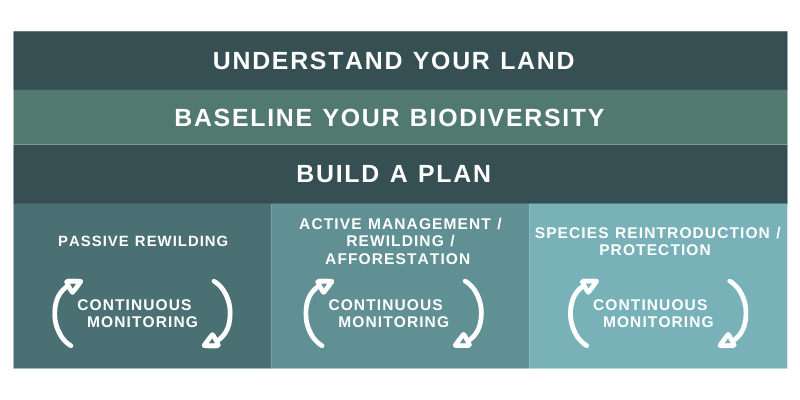Whether you are managing an expansive woodland or a small garden, much enjoyment can be gained from observing the variety of wildlife that either inhabits the land or passes through it. Understanding what biodiversity you have on your land, and measuring changes over time, is an important part of ownership to ensure changes that are occurring are positively affecting wildlife.
Where to Start
Biodiversity can be defined as the variety of plant and animal life in a particular habitat, a high level of which is usually considered to be important and desirable.
There are many species groups (including birds, mammals, invertebrates, vegetation, etc.) that require different approaches to effectively monitor across small and large landscapes. The species groups you choose to monitor will depend on your land (and what habitats exist), what your needs are and what you’re interested to learn more about. Fortunately we are lucky that plenty of expertise exists across multiple groups that you can rely on for expertise, guidance and monitoring services.
Unless you have a target to protect or introduce a specific species, you won’t generally have biodiversity targets to aim for. More often, you are generally just trying to have a positive net effect on plant and animal life. Initial surveying will help you baseline your current levels of biodiversity, from which you can then perform regular monitoring to understand the change over time.
By gathering information about your land and building a full inventory of habitats, you will be able to build a more effective plan for your land and its monitoring requirements. Our landscape in Britain is a mosaic of different habitats, fragmented by fences and hedgerows. By also understanding your surrounding land, you can also consider how to increase connectivity for wildlife, which may also have a net positive effect on your biodiversity.

Measuring overall biodiversity, or measuring diversity of individual species groups, can be an extensive and time consuming process. However, monitoring some species groups can be good indicators for environmental health; for example earthworm populations can indicate soil health and some bird and bats can be good indicators for insect populations due to their reliance on insect populations.
Species Groups
Species are the building blocks of ecosystems, and the variety of species can be an indicator of ecosystem health. Below are a list of species groups that we are currently focussing on at Carbon Rewild:
Bats
Bats can be found in a variety of habitats (urban, woodland, wetlands, caves… you get the idea), which means they can often be found in almost every corner of the country.
Several key species can be identified, including several indicator species. Due to their reliance on significant insect populations, their population can reflect the health of the local environment, even in a short space of time. There are several indicator bat species in the UK, including lesser horseshoe bat, common pipistrelle, soprano pipistrelle, Daubenton’s bat, Natterer’s bat, serotine and noctule.
Due to the nocturnal behaviour bioacoustic (audio) monitoring is generally considered the best way to detect bat species. Just like a bird call, different species have their own echolocation calls, and remote detectors can collect species data.
(Other) Mammals
The UK has an abundance of Mammals (other than bats) that often give land its personality. From hedgehogs, badgers and foxes, to the rarer pine marten and wildcat, mammals can be observed almost everywhere. They can be easily identified using camera traps, which is a common monitoring technique.
Smaller mammals (such as the harvest mouse and bank vole) are also important to monitor due to the consistent loss of population and degradation of their natural habitat. Modified camera traps can be designed to monitor smaller mammals that often aren’t picked up by normal camera trap set ups.
Birds
Birds are a significant species group due to the considerable diversity in the UK, with major surveying events taking place throughout the year to estimate species presence and population. Many bird species in the UK have seen their populations decline significantly in recent decades, with much of their natural habitats depleted. Fortunately we have seen positive effects on bird species through successful conservation programmes and rewilding projects in recent years. It is vital for us to monitor birdlife so we may better understand how land changes can impact bird diversity and abundance.
Along with unique visual features that help us differentiate species, we can also use birdsong and birdcalls to identify species. Advances in remote recording technology as well as software designed to identify species from recordings has made bioacoustic monitoring an accurate and less time-intensive form of bird monitoring.
Want to learn more?
Interested in biodiversity monitoring or want to learn more about our services? Email us here to get in touch or check out our monitoring services at the link below.
